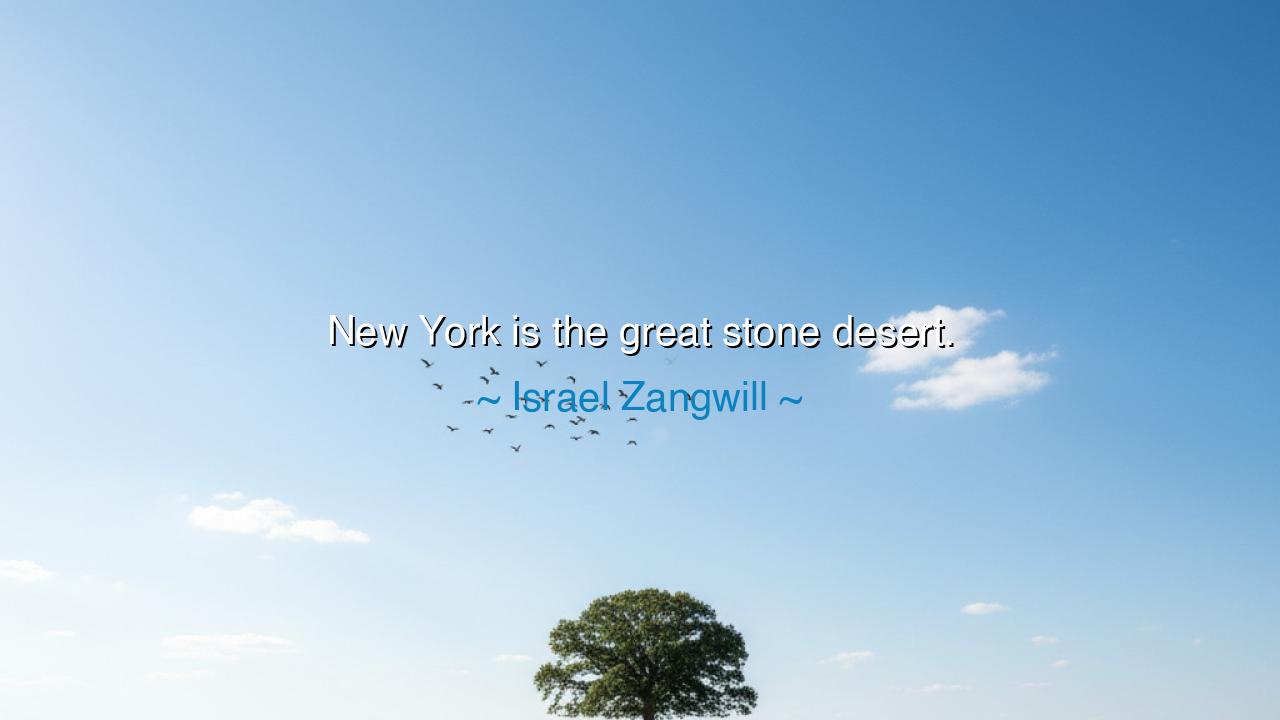
New York is the great stone desert.






Hear, O listeners, the somber words of Israel Zangwill: “New York is the great stone desert.” Though brief, this phrase holds within it a vision of grandeur and barrenness alike. It speaks of a city immense in strength, built not of earth and green fields but of towering walls of stone and iron. And yet, for all its magnificence, it can feel desolate, its human throngs not always enough to fill the emptiness that lies beneath its endless architecture.
What is a desert but a place where life struggles to bloom, where the soul longs for water, for shade, for solace? And what is stone, but cold, unyielding, eternal? By calling New York the stone desert, Zangwill reminds us that while this mighty city rises like a monument to ambition, it may also starve the spirit of gentleness, of nature, of quiet. It is a place where man’s hand has reshaped the land so completely that the soft breath of the earth is drowned beneath the weight of stone towers.
Yet, let us not misunderstand him. In every desert, life endures in hidden ways: the cactus blooms, the bird sings, the well lies waiting beneath the sand. So too in New York, beneath the steel and stone, the human spirit persists—burning with energy, striving with hunger, creating with fire. The city may appear barren of natural beauty, but it is rich with another kind: the ceaseless pulse of humanity, the collision of cultures, the unending invention of its people. The stone desert is harsh, but it forges strength.
Consider the immigrants of the early twentieth century, who poured into this stone desert by the millions. They arrived weary, poor, and trembling with hope, gazing upon the Statue of Liberty as they entered its harbor. To them, the city seemed vast and unfeeling, its streets choked with stone, its people rushing like ants. And yet, within this desert, they built communities, businesses, synagogues, churches, and neighborhoods. Like desert flowers, they found ways to bloom in the cracks of the stone, turning emptiness into life.
History gives us another image: the Dust Bowl migrants of the 1930s, who fled barren lands of dust and despair, only to find New York and other cities towering in cold splendor. To many, the metropolis seemed as unwelcoming as the desert they had left—hard to conquer, indifferent to their suffering. But those who endured found in it opportunity, for the city’s barrenness was not without hidden wells of promise. The stone desert demanded resilience, and in that demand, it shaped character.
The lesson for us is twofold. First, beware the danger of creating cities so filled with stone that they crush the spirit of nature. Remember that humanity cannot live by commerce and ambition alone—we require beauty, greenery, and silence, as much as we require walls and markets. Second, recognize that even in barren places, life can flourish. The stone desert may be daunting, but within it lies the chance to forge greatness, to test resilience, and to create beauty where none seems possible.
Practically, this means: when you walk through your own “stone desert,” whether it be the city or the hardships of life, look for the hidden wells. Seek out the parks, the communities, the friendships, the works of art that spring up in unlikely places. Do not be daunted by cold stone walls, for the desert itself can teach endurance and strength. Yet also labor to bring life to the barren places—plant trees, create gardens, foster kindness, speak warmth where the world seems cold.
Therefore, O children of tomorrow, remember the words of Zangwill. New York is indeed the great stone desert, but deserts are not lifeless; they are lands of testing, of struggle, and of unexpected beauty. Let us learn to endure their harshness, to find the hidden water, and to plant seeds where others see only emptiness. In this way, the desert of stone shall be transformed into a garden of spirit.






AAdministratorAdministrator
Welcome, honored guests. Please leave a comment, we will respond soon